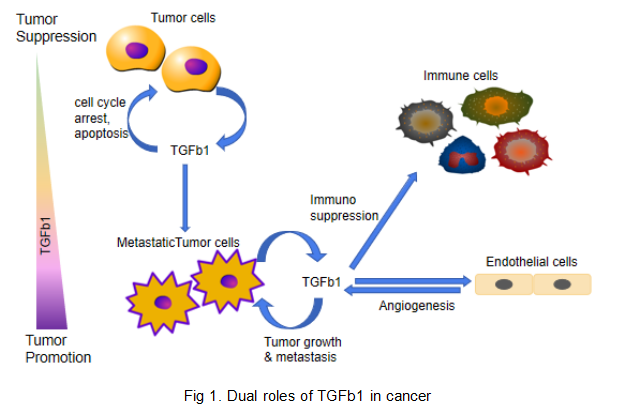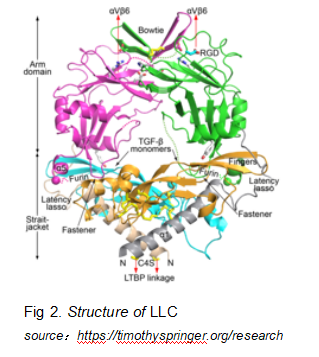TGFb1 - an angel or a devil?
TGFb1 - An angel or a devil?
Recently, researchers found that Transforming Growth Factor beta 1 (TGFb1) has two sides in tumor. It is a tumor suppressor through decreasing the proliferation of cancer cells, but in the mean while, it is also a tumor promoter by promoting formation of tumor micro-environment which benefits the growth, infiltration and transfer of tumor cells.
Next, we will make a brief introduction of the regulating function of TGFb1 in tumor, its clinical value and quantification method.
TGFb1 belongs to TGFb subfamily, this family also includes TGFb2, TGFb3, TGFb4, et al. Proteins in TGFb subfamily are multifunctional, they regulate cell growth and differentiation in body. The abundance of TGFb1 is higher than 90%, its function is also the strongest. TGFb1 not only plays an important part in cell growth, proliferation, differentiation and apoptosis, but also regulates inflammation and immune reaction, it is engaged in various kinds of physiological and pathological processes, like wound healing, vasculogenesis, immune diseases, tumor occurrence and development, et al.
The multiple regulating function of TGFb1 endows it with both positive and negative aspects in tumor development. In the early stage of tumorigenesis, TGFb1 mainly functions to anti-tumor, as it inhibits the growth and proliferation of most cells, including tumor cell. TGFb1 inhibits cell proliferation by cell cycle arrest, prohibiting cell from G1 phase to S phase. However, in the middle and later periods of tumor, receptor of TGFb1 on tumor cellular membrane decreases, it leads to tolerance of growth inhibition signal from TGFb1, in consequence, the proliferation of tumor cell will not be inhibited by TGFb1. In the mean while, tumor cell can secret large amount of TGFb1, then high level of TGFb1 will lead to immunosuppression, that means activation and differentiation of T/B lymphocyte and NK cell will be inhibited, it will cause immune dysfunction, and then, tumor cell will escape from the immune system. Moreover, TGFb1 can promote the proliferation of vascular endothelial cell and formation of vascular in tumor, therefore create suitable micro-environment for growth and transfer of tumor through providing oxygen and nutrient substance. In sum, TGFb1 works as two roles which have absolutely reverse functions in tumor occurrence and development.

As the expression level relates to many diseases and tumor, TGFb1 could be used as a new effective blood biomarker to help diagnose and evaluate tumor. Clinical data shows that TGFb1 level in peripheral blood is positive correlated with tumor size, and its level increases according to the progress of tumor in colorectal, pancreatic, uterine, epithelial ovarian cancer and et al. So, TGFb1 could be used as tumor marker together with CEA.
Since the dual function of TGFb1 was found in MD cancer center of Texas, it has been a new hotspot in cancer research. While in all researches, the quantification of the molecule is the basic need. How to quantify its concentration then? It is a tough work.
1. Preparation of samples
If TGFb1 is tested directly, a very low level of concentration will be gotten, however, as it is known, this molecule expressed in most tissues and cells, why can’t it be detected? This question puzzles the researchers for a long time. Then they found TGFb1 regularly noncovalently combined with its propeptide, and existed as precursor of inactive homodimer. TGFb1 homodimer combined with Latency Associated Peptide (LAP) to form a complex, which is called Small Latent Complex (SLC). And SLC could combined with Latent TGFb-binding Protein (LTBP) to form a more complicated Large Latent Complex (LLC), then TGFb1 will secret to extracellular matrix as LLC. That means TGFb1 exists as LLC format in serum, plasma and other kinds of biological fluids. Precisely quantification of TGFb1 needs pre-treatment of samples, in order to dissociate the molecule from the complex. Based on this characteristic, Cloud-Clone had developed specific activator, TGFB1 Activation Reagent, for TGFb1 detection. This activator provides an easy to use and high-efficiency way to dissociate TGFb1 from the complex in biological samples.

2. Qualified quantification kit
Specific TGFb1 quantification kit from Cloud-Clone was developed for researchers in cytobiology, immunology, oncology, et al. Till now, this kit has been reported to be used in nearly 60 published article, accumulative impact factor has been higher than 200. To help more researchers, Cloud-Clone had worked hard for over ten years, and will continue to do so.
Table 1. Part of citations used Cloud-Clone TGFb1 quantification kit.
Title | Journal Name |
Nose-to-brain delivery of insulin enhanced by a nanogel carrier | Journal of Controlled Release |
Systemic and Tumor Th1 and Th2 Inflammatory Profile and Macrophages in Lung Cancer: Influence of Underlying Chronic Respiratory Disease | Journal of thoracic oncology |
MSX3 Switches Microglia Polarization and Protects from Inflammation-Induced Demyelination | Journal of Neuroscience |
Dexamethasone reduces serum level of IL-17 in Bleomycin-A5-induced rats model of pulmonary fibrosis | Artificial Cells Nanomedicine and Biotechnology |
Metformin attenuates cardiac fibrosis by inhibiting the TGFb1–Smad3 signalling pathway | Cardiovascular Research |
Tumor-associated macrophages promote tumor metastasis via the TGF-b/SOX9 axis in non-small cell lung cancer | Oncotarget |
Renal Denervation Attenuates Multi-Organ Fibrosis and Improves | CELLULAR |
Vascular Remodeling in Rats with Transverse Aortic Constriction Induced Cardiomyopathy | CELLULAR PHYSIOLOGY AND BIOCHEMISTRY |
For more information, please contact www.cloud-clone.us.
